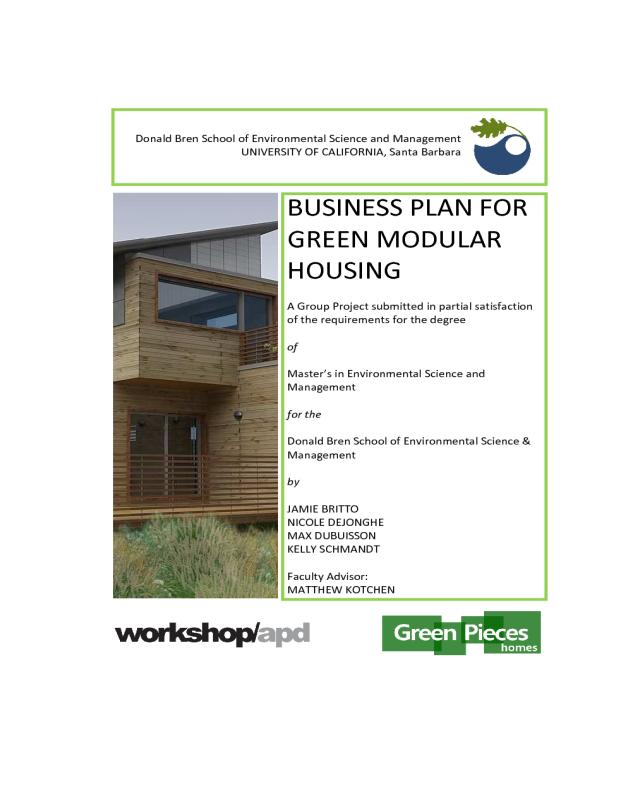Fillable Printable Business Plan for Green Modular Housing
Fillable Printable Business Plan for Green Modular Housing

Business Plan for Green Modular Housing

Donald Bren School of Environmental Science and Management
UNIVERSITY OF CALIFORNIA, Santa Barbara
BUSINESS PLAN FOR
GREEN MODULAR
HOUSING
A Group Project submitted in partial satisfaction
of the requirements for the degree
of
Master’s in Environmental Science and
Management
for the
Donald Bren School of Environmental Science &
Management
by
JAMIE BRITTO
NICOLE DEJONGHE
MAX DUBUISSON
KELLY SCHMANDT
Faculty Advisor:
MATTHEW KOTCHEN

BUSINESS PLAN FOR GREEN MODULAR HOUSING
As authors of this Group Project report, we are proud to archive it on the Bren
School’s web site such that the results of our research are available for all to read.
Our signatures on the document signify our joint responsibility to fulfill the archiving
standards set by the Donald Bren School of Environmental Science & Management.
Jamie Britto
Nicole DeJonghe
Max DuBuisson
Kelly Schmandt
The mission of the Donald Bren School of Environmental Science & Management is
to produce professionals with unrivaled training in environmental science and
management who will devote their unique skills to the diagnosis, assessment,
mitigation, prevention, and remedy of the environmental problems of today and the
future. A guiding principal of the School is that the analysis of environmental
problems requires quantitative training in more than one discipline and an
awareness of the physical, biological, social, political, and economic consequences
that arise from scientific or technological decisions. The Group Project is required of
all students in the Master’s of Environmental Science and Management (MESM)
Program. It is a four quarter activity in which small groups of students conduct
focused, interdisciplinary research on the scientific, management, and policy
dimensions of a specific environmental issue. This Final Group Project Report is
authored by MESM students and has been reviewed and approved by:
Matthew Kotchen, Faculty Advisor
Ernst von Weizsäcker, Dean
Date
ACKNOWLEDGEMENTS
We would like to thank the following people for all of their help and support through
the completion of this project:
Matthew Kotchen – Faculty Advisor
Matthew Berman and Andrew Kotchen – Clients
Dennis Allen
The Architecture 2030 Group Project
Doug Cerf
Michelle Chang
Joey Coleman
Michelle Corti
Ian Cronshaw
Bliss Dennen
Ian Fisk and the William James Foundation
Marie Fukudome
John Greathouse
Gary Hansen
Grant Jacobsen
Jimi Kallaos
Gary Libecap
Jennifer Miller
Jim Morouse
Erin Myers
Greg Sloditskie
vi
vii
TABLE OF CONTENTS
PROJECT DESCRIPTION ........................................................................................ IX
BUSINESS PLAN ...................................................................................................11
SUMMARY.................................................................................................................................. 12
PRODUCT DESCRIPTION.............................................................................................................. 13
MANUFACTURING AND OPERATIONS PLAN................................................................................ 17
MARKET ANALYSIS AND SALES PLAN........................................................................................... 19
RISKS .......................................................................................................................................... 25
TIMELINE AND GROWTH PLAN.................................................................................................... 27
FINANCIAL PLAN ......................................................................................................................... 29
INVESTMENT PROPOSAL............................................................................................................. 32
MANAGEMENT TEAM AND ORGANIZATIONAL STRUCTURE ........................................................ 33
SUPPORTING RESEARCH......................................................................................39
1 BACKGROUND.......................................................................................................................... 39
1.1 Growing Awareness of Environmental Problems................................................................... 39
1.2 Rising Energy Costs ................................................................................................................ 42
1.3 Health Concerns Associated with Buildings ........................................................................... 44
1.4 Environmental Impacts of Homes and Construction.............................................................. 47
2 OPPORTUNITY ......................................................................................................................... 49
2.1 Market Analysis ..................................................................................................................... 49
2.2 Customer Analysis.................................................................................................................. 52
2.3 National Industry Trends........................................................................................................ 56
2.4 Location.................................................................................................................................. 60
3 SOLUTION ................................................................................................................................ 73
3.1 Explanation of Green Pieces................................................................................................... 73
3.2 Product Description................................................................................................................ 77
3.3 Manufacturing and Operations ............................................................................................. 83
3.4 Marketing Plan ...................................................................................................................... 89
3.5 Financial Plan......................................................................................................................... 98
3.6 Execution Plan...................................................................................................................... 114
3.7 Management Team and Organizational Structure.............................................................. 116
3.8 Risks ..................................................................................................................................... 122
4 APPENDICES........................................................................................................................... 124
APPENDIX 1: Types of Construction ........................................................................................... 124
APPENDIX 2: Conneticut Prototype Designs (workshop/apd).................................................... 126
REFERENCES CITED ............................................................................................129
viii

ix
PROJECT DESCRIPTION
This project is the result of a new collaboration, dubbed Eco-Entrepreneurship,
between the Bren School and the Technology Management Program in the
Engineering Department at UCSB. By taking classes in both programs, students are
given training in both environmental management and new venture creation, giving
them the tools to create new businesses that can achieve a triple bottom line
(environmental, social and financial).
The proposal for this project came from our clients, the design firm of
workshop/apd. Principal designers Andrew Kotchen and Matthew Berman were
interested in developing the idea of green modular housing into a viable business
that could stand apart from their existing architecture and design company. This
idea came from their experience in entering, and winning, a design competition
sponsored by Global Green USA and Brad Pitt, the focus of which was to sustainably
rebuild a city block in the hurricane-ravaged Ninth Ward of New Orleans.
Construction on this project should be completed during 2008.
Organization of the document
There are two main deliverables of this project, which have been combined to form
this final report: the first is a concise business plan that can be sent to investors, and
the second is a compilation of the analytical research that was carried out in support
of the business plan. Since the conclusions and information in the business plan are
directly formed from the supporting research, there will be repetition. The two
sections are meant to be read as separate entities.
A business plan is inherently a living document, evolving as the business develops
and new decisions are made, so this document represents a snapshot in time of the
business plan. As the company is formed and work begins, the shape of the business
will likely change from what is represented here.
10

11
BUSINESS PLAN
“Green living for the rest of us”
www.greenpieceshomes.com
Contact: modula[email protected]
Donald Bren Hall, University of California, Santa Barbara, CA 93106-5131



